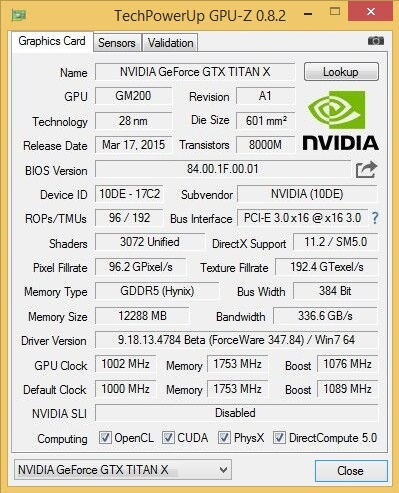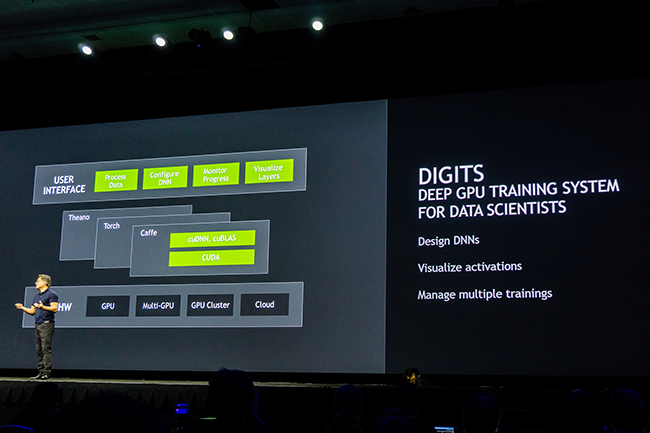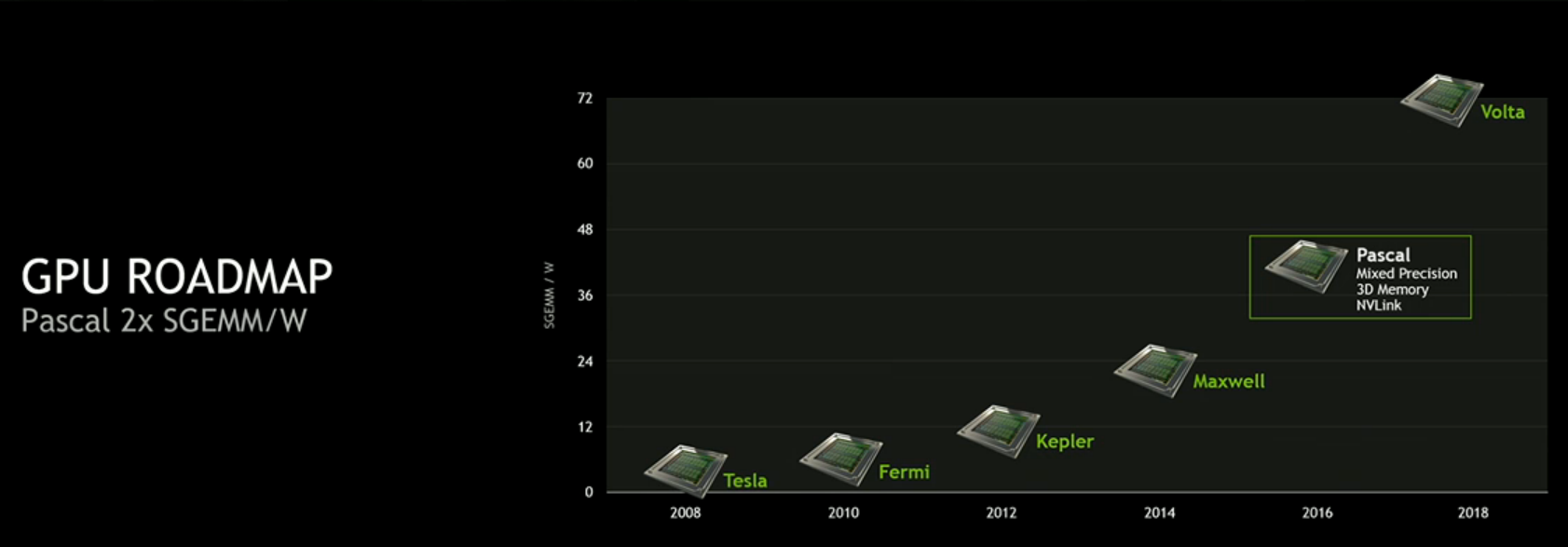nVidia showed unmanned vehicle platform and the most powerful GPU in the world
The head of Tesla, Ilon Musk, went on the scene.
 On Tuesday, nVidia showed the most powerful (among systems with one graphics processor) Titan X video accelerator with 12 gigabytes of memory. The retail cost of new items will be from 999 dollars. Also in the hands of the head of nVidia Ren-Sun Juan appeared car drive Drive PX, which is designed to become the core of autonomous machines.
On Tuesday, nVidia showed the most powerful (among systems with one graphics processor) Titan X video accelerator with 12 gigabytes of memory. The retail cost of new items will be from 999 dollars. Also in the hands of the head of nVidia Ren-Sun Juan appeared car drive Drive PX, which is designed to become the core of autonomous machines.The new Titan X was shown on March 4, two weeks ago, but the ad looked crumpled and too empty. At that time, the GDC conference was taking place, and during a talk with representatives of Epic Games about its Unreal Engine game engine and its demands for hardware , Juan suddenly appeared on the stage as a special participant. There, the executive director of nVidia spoke about the new video card, without going into too much detail.
Specific characteristics were not disclosed then, technical publications, which could get acquainted with the new card closely, were forbidden to distribute any data, except for photos. It was said that the video memory will be 12 gigabytes, and the chip will have 8 billion transistors. Only two weeks later, a full-fledged announcement took place at the GPU Technology Conference, where the characteristics and price of the new video accelerator were heard, and right after that, Titan X reviews and tests ( 1 , 2 , 3 , 4 , 5 ) appeared on the network.

')
Titan X is already on sale. The core of the video card is a GM200 chip with 3072 CUDA cores, 192 texture units and 384-bit memory. Above is a simplified device of this chip. On March 4, at the GDC gaming conference, the thought was sounded that this power is needed for virtual reality helmets, and this Tuesday was devoted a lot of time to machine learning systems and neural networks.
| Titan x | GTX 980 | Titan black | R9 290X | |
|---|---|---|---|---|
| Graphics processor | GM200 | GM204 | GK110 | Hawaii XT |
| GPU core | 3072 | 2048 | 2880 | 2816 |
| Base frequency | 1000 MHz | 1126 MHz | 889 MHz | 1000 MHz |
| Texture blocks | 192 | 128 | 240 | 176 |
| ROP blocks | 96 | 64 | 48 | 64 |
| Memory | 12 GB | 4 GB | 6 GB | 4 GB |
| Memory frequency | 7000 MHz | 7000 MHz | 7000 MHz | 5000 MHz |
| Memory bus | 384-bit | 256-bit | 384-bit | 512-bit |
| Memory bandwidth | 336 GB / s | 224 GB / s | 336 GB / s | 320 GB / s |
| Heat dissipation | 250 W | 165 W | 250 W | 290 W |
| Peak performance, gigaflops | 6144 | 4612 | 5121 | 5632 |
| Number of transistors | 8.0 billion | 5.2 billion | 7.1 billion | 6.2 billion |
| Technical process | 28 nm | 28 nm | 28 nm | 28 nm |
| Recommended price | $ 999 | $ 549 | $ 999 | $ 359 |
| Launch date | 2015-03-17 | 2014-09-18 | 2014-02-18 | 2013-10-24 |
 Titan X uses the same Maxwell architecture as the GTX 980, GTX 970 and GTX 960. Roughly speaking, in terms of performance it’s one and a half GTX 980: 50% more cores, ROP blocks, texture units, memory bus width and second-level cache . During the presentation, Juan also mentioned peak performance of 7 gigaflops, which is different from what was stated above. This performance is achieved at the highest possible frequency. The predecessors of Titan and Titan Black had a performance with double calculations three times lower than in ordinary ones with single. Titan X doesn’t have this feature, and double-precision calculations are 32 times slower - just 192 gigaflops.
Titan X uses the same Maxwell architecture as the GTX 980, GTX 970 and GTX 960. Roughly speaking, in terms of performance it’s one and a half GTX 980: 50% more cores, ROP blocks, texture units, memory bus width and second-level cache . During the presentation, Juan also mentioned peak performance of 7 gigaflops, which is different from what was stated above. This performance is achieved at the highest possible frequency. The predecessors of Titan and Titan Black had a performance with double calculations three times lower than in ordinary ones with single. Titan X doesn’t have this feature, and double-precision calculations are 32 times slower - just 192 gigaflops.By the way, the memory is not divided into two parts, as happened with the GTX 970 . The Titan X has no segmenting, some of which may be slower than others, says nVidia.
The configuration of the GM200 chip is maximum, there are 24 SMX modules in it, that is, there is no other more productive option. The chip is quite large, 8 billion transistors fit on an area of approximately 25 × 25 mm or 625 mm². For comparison: the area considered to be large GK110 (7.1 billion transistors) reached 561 mm². The Titan X's frequencies are slightly (≈13%) lower than those of the GTX 980. The base frequency is 1000 MHz, the maximum reaches 1075 MHz, in 980 these sink values are 1126 and 1216. nVidia states that overclocking to 1.4 GHz is theoretically possible when cooled by air. The memory frequency is the same - 7 GHz. The most amazing feature of the Titan X is 12 gigabytes of video memory, three times the size of the GTX 980 and twice the size of the GTX Titan Black. In the presentation, nVidia touched upon the problems of 4K games, but so far it will be difficult to imagine games and monitor configurations that require 12 GB of video memory.

Nvidia also talked about how SpaceX, America’s number one space company, uses video accelerators in its work. The head of the SpaceX development department, Adam Lichtl, explained how the simulation of complex physical models became possible on video cards. This task could require thousands of conventional processor cores - this is a matter of iottabaytah (this prefix means 10 24 ), which are formed in the analysis of models of ignition of fuel components.

But without the appropriate software to use the power of video cards is impossible. Nvidia talked about DIGITS, this is a neural network creation software for researchers. Neural networks can be used for learning object recognition, but their creation often causes difficulties and takes a lot of time. According to nVidia, their product can change everything. DIGITS is available for download at https://developer.nvidia.com/digits . Sitema has an intuitive interface and supports the version of the Caffe framework, which is processed by a video card.

DIGITS DevBox is a project of the most powerful desktop data thresher. Four Titan X cards are installed in the computer. At the same time, the entire system remains relatively quiet and energy efficient. DevBox comes with pre-installed software products used in neural network research: it is DIGITS, cuDNN 2.0, Caffe, Theano and Torch. The machine works under Ubuntu.

It is very productive: AlexNet training can take only 13 hours. A system with one video card will take more than 2 days, and on a not very weak processor, this task will take more than a month. The cost of DIGITS DevBox is 15 thousand dollars - this is not a gaming computer for Crysis, but a scientific equipment.

Ren-Sun Huang also discussed the future architecture of Pascal. It will be based on the 16-nm process technology FinFET + - nVidia skips 20 nm. Pascal performance per watt will be more than two times higher than that of Maxwell. Another important improvement is the use of more efficient memory, called High Bandwidth Memory. Nvidia claims that up to 32 GB of memory will be available per graphics processor, and the bandwidth will increase threefold. Thus, theoretically, throughput to terabytes per second is possible.

Pascal-based cards will for the first time use NVLink, a high-speed bus between the CPU and the graphics processor, or between the graphics processors. NVLink speed is significantly higher than that of PCI Express. The memory of the new architecture will use 3D technologies, that is, the chips will have a vertical orientation. As a result of all these innovations, Pascal can process some processes 10 times faster. Special attention is paid to the optimization of tasks of machine vision, image recognition, construction and functioning of neural networks.

Juan showed Drive PX and called its price. This is the autopilot computer, which was first talked about at CES 2015 in January of this year. The motherboard has two mobile Tegra X1 chips with a total capacity of 2.3 teraflops, which are able to process in real time a video stream from 12 different HD cameras using 630 million neural network connections. This computer is created for self-learning systems ADAS and future unmanned vehicles.
Drive PX comes with the DIGITS software mentioned above, as well as video capture and processing libraries. The product is intended for both real automakers and research projects. Autonomous machines are still the future, but the nVidia computer can bring it closer. Sales of Drive PX will begin in May, the cost of the platform is 10 thousand dollars.

Shortly before the announcement of Drive PX, Ilona Mask was invited to the scene. He discussed issues of machine vision and autonomous cars. Juan pinned Mask: the head of Tesla is afraid of artificial intelligence , but at the same time believes that unmanned vehicles are much safer than human drivers. Mask explained his position: the danger is only potential, and the autonomous machine has a narrow form of AI. Musk is sure that in the future we will look at the need to drive our cars in the same way as today we perceive the uselessness of the operator in the elevator. Unfortunately, there were no words about the collaboration between nVidia and Tesla.
Based on ExtremeTech ( 1 , 2 ), nVidia blog ( 1 , 2 , 3 , 4 ), Re / code , PC Perspective , Techgage , HotHardware ( 1 , 2 , 3 , 4 ), ITworld , CNET , AnandTech and The Register .
Source: https://habr.com/ru/post/374777/
All Articles